Teams, tales and tips – a guide to the local game
Europe’s most popular football getaway, Barcelona has everything.
Lapped by the Med, the capital of the fiercely independent region of Catalonia offered fizzing nightlife, fine modern dining, quirky tourist attractions and what was, until relatively recently, the world’s most revered football team.
Flagship club of Catalonia, FC Barcelona (‘Barça’) enjoyed many years of extraordinary success in which they dazzled and dominated like no other club. The Nou Camp stadium became a cash cow, living proof of Catalan commercial savvy, while Barça followed their extraordinary treble of 2014-15 with league titles in 2016, 2018 and 2019.
The world may not have seen a team so majestic, nor a player who can change a game as quickly or as elegantly, as FCB and their figurehead, Lionel Messi.





And then it all came crashing down. Poor decisions by club president Josep Maria Bartomeu led to humiliation on the pitch and the departure of a tearful Messi.
In 2021, former Catalan MP Joan Laporta returned as club president, having overseen the rise of the La Masia generation in the early 2000s. One of its key members, impeccable midfielder Xavi, returned as coach and Barça at least became a credible force once more, albeit Messi-less. A first post-Messi title in 2023 was followed by the hiring of star coach Hansi Flick, and the arrival on the world stage of teenage prodigy, Lamine Yamal.
While Barça’s clashes with Real still dominate the Spanish season, their rivalry with cross-city counterparts Espanyol is fierce for completely different reasons. The Parakeets’ greatest victory every season is the rare one they can wrench from their illustrious neighbours.
As a city, though, Barcelona can still trade on the FCB image, not only through the club’s many official stores around town – all pirated Messi shirts have long been removed from those stalls along the Ramblas – but as a brand the same as Gaudí or Miró. The FCB Museum remains Barcelona’s most popular after Picasso’s, even now that the Nou Camp is being completely rebuilt, during which time FCB have been camped out at Montjuïc, former home of Espanyol and stage for the 1992 Olympics that transformed the city.

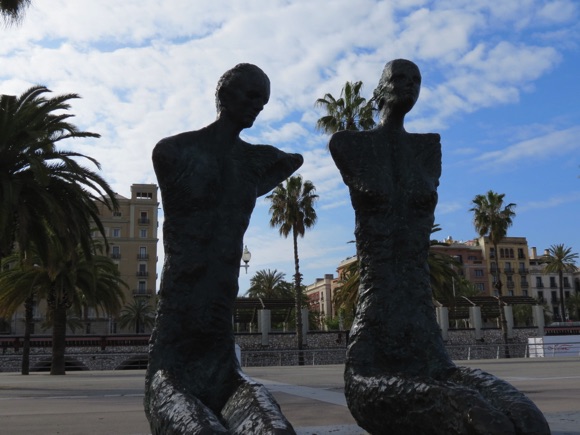

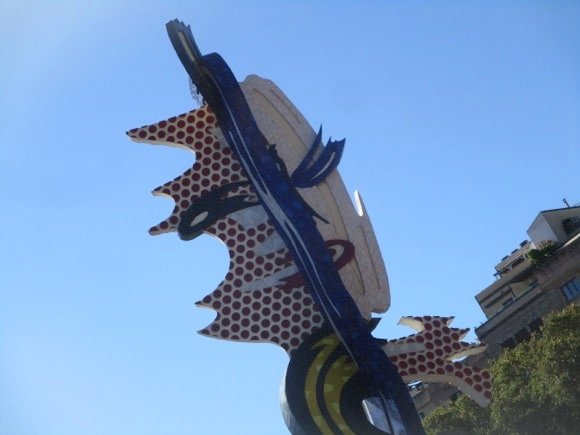

But there’s more to the club than just all those trophies in the museum with Catalan colours tied to the handles. Més que un club, as their motto says. The cavalier team that Dutch total football guru Johan Cruyff developed here nurtured deep-lying playmaker Pep Guardiola. The La Masia graduate would go on to guide FCB’s golden first Laporta era, from which Lionel Messi emerged.
Guardiola’s Barça conquered the world, making him the game’s go-to coach, his possession-based tactics later bringing Manchester City four titles in five years. Untold wealth may have enabled the Premier League to usurp La Liga on the world stage but the master moving the men around it is Barcelona through and through, astute, audacious and cosmopolitan.
The club’s Swiss founder was similar in character. Hans Gamper went full Catalan, learning the local language and changing his first name to Joan. Bound for Africa, this sport-loving young merchant had stopped off in Barcelona at just the right time. The city was just embracing its Catalan identity and expanding rapidly, swallowing up once separate municipalities such as Sants and Les Corts into the metropolis.
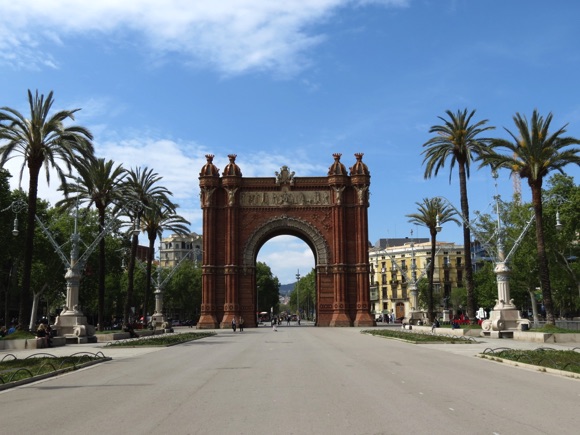




Prosperous and outward-looking, Barcelona attracted an international community to come and do business. When Gamper, who had already played for his home-town team Winterthur and FC Basel in Switzerland, tried to join the first football club founded in Barcelona, Català SC, he was shunned for not being Catalan.
The ad he consequently placed in Los Deportes to form a new club then elicited a cross-section of the mercantile class. Not only were FC Barcelona born but also a first local football rivalry. FCB duly beat Català at the Bonanova Velodrome by Mount Tibidabo on Christmas Eve 1899. Early club president, Barcelona-born Arthur Witty, played alongside Gamper that day. He was one of two expat brothers who soon brought over leather balls and kit from England, although their enthusiasm for the FCB venture waned once Gamper began to prioritise Catalan identity above sport.
Equally dismayed with Català’s Catalan-only policy were members of the firmly Spanish Hispania AC. Attracting key members of Escocés FC, a recently disbanded team of local Scottish workers, Hispania took on FC Barcelona in 1900, the first match Gamper’s men played at the their own ground outside the Casanovas Hotel.





It was Hispania’s president, Alfonso Macaya, who proposed a local football tournament, providing a trophy that reflected the new-found Modernist style prevalent in new Catalan design. Hispania duly won the first Copa Macaya in 1901, FCB the second and the city’s third main club the third. Formed by engineering student Ángel Rodríguez Ruiz, Español comprised his fellow undergraduates at Barcelona University.
Founded by a Spaniard for Spaniards, Español changed their colours to blue and white in honour of a historic French-bashing admiral. They were based near the university in Sarrià, then a separate, well-to-do community only integrated into the city in 1924. Around this time, too, they opened the Sarrià Stadium.
Just the other side of main Avinguda Diagonal, their city rivals FCB had just completed Les Corts, a significant step up from the Camp de la Indústria ground used between 1909 and 1922. So many Barça fans had packed into that tiny ground that they had to sit along the edge of its wall, this strange sight giving rise to their nickname of the Culés, or backsides.
Les Corts hosted the first international to be held in Barcelona, Spain’s 2-1 win over Austria just before Christmas 1924. The winning goal came from Barça hero Josep Samitier, the leading light of the club’s first golden era, pally with Salvador Dalí, a dashing figure in the city’s nightspots. On the pitch, he dictated play from midfield, a tactic later adopted by Cruyff and Guardiola.





Keeping goal that cold December day in 1924 was the polo-necked Ricardo Zamora, who by then had returned to his beloved Español after three seasons at Barcelona. Also locally born, El Divino later kept Spain in the game when La Selección became the first side from outside the British Isles to beat England, in 1929. Later it transpired that he had broken his chestbone while doing so.
Samitier and Zamora were the figureheads of the city’s first football great football epoch. Español won their first Spanish Cup in 1929, Barcelona won the inaugural Spanish league that same year when CD Europa, cup finalists in 1923, were also founding members. Then the de facto third club in town, the Europeístas today play in the fifth tier as CE Europa. Home is the Nou Sardenya on Carrer de Pau Alsina in Gràcia, overlooked by the cosy Bar Paramari.
CD Europa had even broken the FCB-Español monopoly of the Campionat de Catalunya, logical offshoot of the Copa Micaya, awarded since 1904 and professional since 1917, years before the rest of Europe followed suit. This early forerunner of La Liga survived until 1940.
As a football city, Barcelona never hit the heights of the Roaring Twenties until the post-Franco Cruyff and Guardiola eras. Gamper lost all his savings in the Wall Street Crash of late 1929 and committed suicide the following summer.





Soon after, Catalonia gained its autonomy during the early promise of the Second Spanish Republic. The city planned its own People’s Olympiad to rival Hitler’s in Berlin, building a panoramic stadium at Montjuïc. The Spanish Civil War broke out before it could be staged.
Severely bombed in 1938, Barcelona was rebuilt as a post-war industrial powerhouse, the many migrant workers from Andalucia integrating themselves by taking up membership of FC Barcelona, snubbing poorer rivals, Español. This mass support gave rise to a new European era, and the building of the Nou Camp, the one place where Catalan could be spoken freely in Franco’s dictatorship. FC Barcelona were big, Real Madrid were always bigger.
Favoured in the 1940s, Español began to dominate the Derbi barceloní both home and away for the first time, but it wasn’t to last. As the Nou Camp rose and rose, the Sarrià became ever more crammed in by residential blocks, a little fiery cauldron of disgruntlement.





These intimate surroundings proved the perfect setting, however, for three of the most memorable matches in World Cup history, the epic clashes between Italy, Brazil and Argentina in 1982. It was here that Maradona lost his cool, Falcão foxed Italy with a shimmy and Paolo Rossi sent a nation doolally. Across the city, slow handclaps echoed around a 120,000-capacity Nou Camp as Poland and the USSR went through the motions against the backdrop of Solidarity protests.
Español brought the Sarrià to life again in 1988 for their run to the UEFA Cup final, a triumphant 3-0 win in the first leg here, a bitter shoot-out defeat for the second leg at Leverkusen. In the Catalan resurgence of the 1990s, the club was forced to adopt the name Espanyol, then had to sell the Sarrià for real estate and move up to Montjuïc.
The Olympic Stadium had welcomed the city’s triumphant return to the world stage, the 1992 Games initiating significant urban development just as Cruyff’s FC Barcelona were beating the best in Europe. An honorary Catalan, the Dutch master had named his son after the local patron saint. His playmaker, Guardiola, has never been shy in his support for Catalan independence. Neither could have been so brazen in previous times.




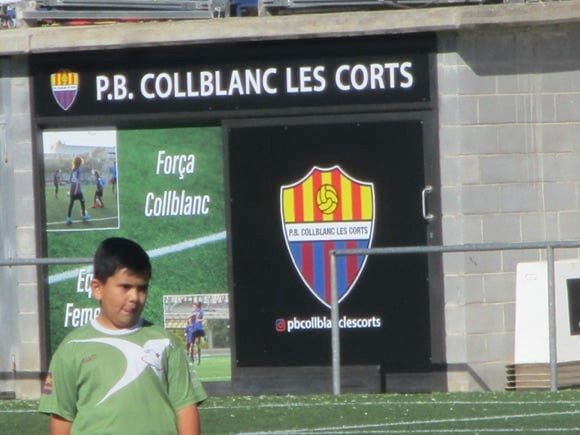

For Espanyol, the contrast couldn’t be more striking. Stuck at Montjuïc for 20 years, Espanyol are now based at the modern RCDE Stadium, out towards the airport, still supported by a passionate core of followers with a collective chip on their shoulders.
FC Barcelona moved up to Montjuïc before the 2023-24 campaign during the redevelopment of the Nou Camp. Or rather, Spotify Camp Nou, the club having struck a deal with the controversial streaming giant for stadium and shirt sponsorship. As the 2024-25 season wore on, both Barça and Spotify greeted the continuous delays to its reopening with dismay, hopes of an unveiling by May disappearing with each announcement.
Meanwhile, there was still football going on at the Nou Camp – or rather, the pitch immediately behind it. Formed by Barça fans back in 1956 and originally called Peña Kubala after the hero of the era, the since renamed PB Collblanc now comprises 19 teams from kids to seniors in the lower reaches of the Catalan regional league, games taking place in a friendly family atmosphere.
Getting Around
Arriving in town and local transport


Barcelona Airport at El Prat de Llobregat is 18km (11 miles) south-west of the city. Terminals 1 and 2 are on metro line 9, with a train every 7mins that calls at Collblanc near the Nou Camp, connecting with line L3 that stops at Sants main train station and central Plaça d’Espanya.
A single ticket into town (€5.15, 30mins) can be bought from a machine at the airport station. Note that the T-ticket (€11.35) for ten journeys on the TMB Barcelona transport system isn’t valid for line 9 from/to the airport. Once in town, a single ticket is €2.40. A T-dia (€10.50) 24-hour pass is also valid for one trip to and from the airport.
A better option might be the Hola Barcelona travel card, for stays of two to five days, available online for a 10% discount and from the tourist information desk at Terminal 2 of Barcelona airport. From €14.76/€16.40 for 48 hours to €38.20/€34.38 for 120, it includes return travel from/to the airport, and all transport in town including the Montjuïc funicular (though not the cable car).
A half-hourly train on the Rodiales R2 Nord line leaves terminal 2 for Sants (€4.60, 25mins). From terminal 1, take the shuttle bus to terminal 2. An Aerobús (€5.90/return €10.20, 35mins) runs every 5-10mins to the main square of Plaça Catalunya.
A taxi to the centre should cost about €35-€40. Around town, black-and-yellow taxis are hailed from the street – the green light should be on and the windscreen sign displaying the words lliure/libre. Taximés (+34 933 300 300) also offer online and app booking.
Where to Drink
The best pubs and bars for football fans













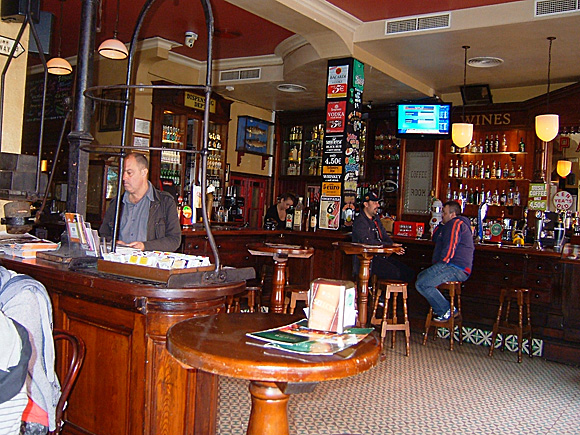

Bar-wise, most of the action takes place around the Barri Gòtic with some gems hidden around the Born. Showy, mainstream Port Olímpic hots up in summer. Damm Estrella is the local beer, along with its stronger cousin Voll Damm, and thankfully revived Moritz, Barcelona’s oldest brand. Football bars abound.
Just off the Ramblas and main Plaça Reial, on Carrer de Ferrán, you find several match-watching options, starting with the pub-like Temple Bar at No.6, My Bar next door and the lively Lennox The Pub (No.7) opposite, a brand successfully established in Palma, Mallorca.
Nearby, on Carrer del Cardenal Casañas, the Bar International Beer and 17-tap Kaelderkold appeal to thirsty young backpackers. Over on Carrer de la Boquería, Cheers serves Moritz, Paulaner and Guinness on draught while you watch the match and peruse their scarf collection. Flaherty’s on Plaça de Joaquim Xirau is good for live sports while across the Ramblas, the Wild Rover shows games on three giant screens and six TVs.











Right on the Ramblas, the Old Irish Pub is neither old, nor Irish nor a pub but draws a lively Euro party crowd thanks to its location and late opening hours. If you get dragged this way, remember that you’re close to the edgy Raval district so be on your guard as you stumble out.
Also around the Raval, the Shamrock features a large street terrace where everyone sits out in warmer weather.
It’s a short walk from focal square Plaça Catalunya, where Belushi’s welcomes all-comers for TV sport, table football and drinks, although it’s attached to a youth hostel. Perhaps a more comfortable choice, one street over, would be Scobie’s, named after a pub in Ireland that closed in 2001, which is when this convivial hostelry, with its huge range of sports channels and well-chosen photography, opened.










Nearby, The George Payne by Urquinaona metro shows soccer, too, while further down the Via Laietana, green-fronted McCarthy’s is a major gathering place for sports fans, passing tourists and its many loyal regulars. Along Laietana by Jaume I metro, Dunne’s is part pub, part steakhouse, its accent on the kitchen without forgetting the sport.
For sport combined with craft beer and board games, contemporary CocoVail attracts hopheads, students and football fans, a streetwise beerhall just off Passeig de Gràcia on Carrer d’Aragó.
Where Aragó meets Carrer de Balmes, the Seven Sports Bar Barcelona provides welcome respite from all the Irish pubs, a large, lively place dotted with TV screens and decked out in red, colour scheme of main sponsors, Estrella. Generous happy hours and a terrace overlooking a busy corner encourage you to linger.













Near the Picasso Museum on C/de l’Allada-Vermell, the Black Horse has long been a football-friendly favourite. If you’re visiting the Sagrada Família, across the square stands one of Europe’s finest Celtic pubs, Michael Collins is approaching its 30th anniversary looking just as authentic as the day it opened. Assembled in Ireland and put together here, framed Celtic shirts and all, it schedules daily football action, regular live Irish music and quiz nights.
Further afield, the excellent Sonora Sport Tavern is well conceived, done out with retro Americana and with tables outside – but it’s a bit of a walk from Marina metro station in Poble Nou. Later on at night, there are few other options nearby.
At the Marina Port Vell, the Fastnet features a harbour-facing terrace and Sky Sports TV inside. Nearby, tucked-away Ca’l Chusco (Almirall Aixada 5) by Carrer del Mar is a real local football haunt, with live TV, a betting board and affordable food and drink in a morass of tourist traps.
Where to stay
The best hotels for the stadiums and city centre









Barcelona Turisme has a room-booking service.
With FC Barcelona now playing up at Montjuïc until 2025 at least, a hotel room near Plaça d’Espanya might be the most convenient for the hilltop stadium. In the Barceló chain, the Occidental Barcelona 1929 takes its name from the exposition for which this main square was laid out, and its design influences from the boutique-led trends of recent years. All topped by a rooftop pool, sun terrace and cocktail bar.
Alongside, the Catalonia Barcelona Plaza is surprisingly affordable if booked directly, given its rooftop pool, spa and gym – not to mention location. Also close to the square, on the main avenue it is named after, the Barcelona Gran Via España is another showy four-star, Catalan tapas and inventive cocktails making up for the lack of a panoramic swim.
The other main junction for Montjuïc is Paral.lel, a short funicular ride away. Near the lower terminus, the Hotel Barcelona Universal is a handy upper mid-range option, with its own rooftop pool and terrace. Slightly further away, the three-star Lugano offers free breakfasts if you reserve one of its comfortable, mid-range rooms directly through its site.
















If you’re doing the FCB museum at the Nou Camp, the nearest hotels are the smart four-star Hotel Madanis by the bars on C/Riera Blanca, and near the partner apartment hotel for groups of three to five people. Round the corner on Travessera de les Corts, the revamped Spanish chain NH Barcelona Stadium has a (pocket-sized) rooftop pool, alongside which you can see the Nou Camp being rebuilt without leaving your sun lounger.
You’ll find more rooftop swimming at the ILUNION Les Corts Spa near the stadium on C/Cardenal Reig. More modest but closer to the ground is the Alguer Camp Nou on Passatge de Pere Rodriguez.
North of the stadium towards Maria Cristina metro station, and both a short walk downhill to the Nou Camp, the reconfigured, rebranded SOFIA Barcelona is a five-star with a spa and all the trimmings while, even closer, the four-star Catalonia Rigoletto also features a rooftop pool.
Beyond the Nou Camp on Diagonal, the high-design Grand Hyatt attracts discerning guests with its Oasis Spa and LEÑA restaurant by top Andalusian chef Dani García. Round the corner, the Hilton Barcelona caters to the business community with its gym, restaurant and meeting rooms.














For something more affordable in the same vicinity, Les Corts ONEFAM off Avinguda de Madrid shows how hostels have moved with the times, with its rooftop pool and Netflix common room. Across Gran Via de Carles III, Room 018BCN is similar in offer, though bathroom space is at a premium.
An easy hop away, the chic chain Barceló Sants sits atop the station of the same name while round the corner, the Expo Hotel Barcelona on Carrer de Mallorca has a rooftop pool.
Closer to focal Plaça de Catalunya, the Catalonia Ramblas offers a pool and spa. Alongside, the mid-range Regina dates back to 1917. Across the street, St Christopher’s caters to budget-conscious visitors with dorm beds, private doubles and sports bar Belushi’s. Nearby Hotel Jazz belies its three-star status with a rooftop pool, solarium and lounge bar.
Right on the square itself, the H10 Catalunya Plaza combines vintage and contemporary in a building dating back to the 1800s, while the Plaza Catalonia on adjoining Carrer de Bergara sets up an outdoor pool surrounded by gleaming building façades, right in the heart of the city.



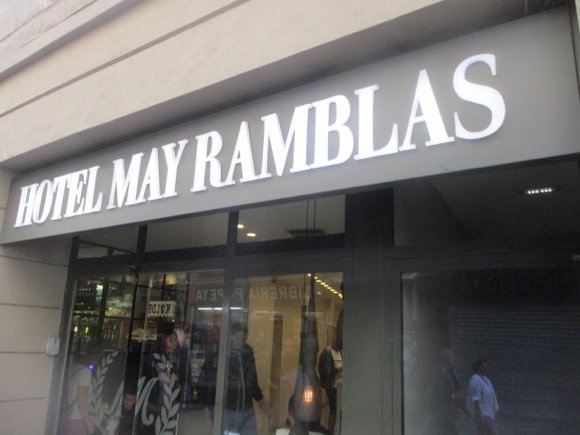





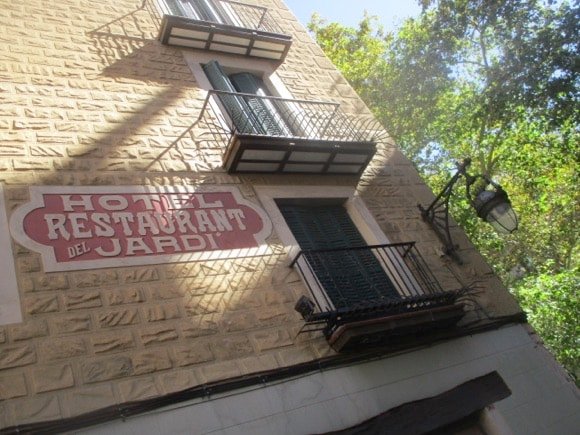



For the Ramblas and bar zone, on the main drag, the Royal Ramblas couldn’t be better located if crowds aren’t an issue, a 10% discount currently offered for stays of four nights or more. Also by Liceu metro, the mid-range May Ramblas runs from boxy singles to suites with balconies.
Deeper in the bar quarter, family-run El Jardí dates back to 1860, its current look the result of a 21st-century makeover which also included a lift for the higher part of the building. Just behind it, the Racó del Pi fills a listed building with mid-range guest rooms.
Across the Ramblas, the Hotel SERHS Rivoli Rambla fills a neo-classical building with smallish, mid-range rooms and an equally petite, though panoramic, gym and jacuzzi. Alongside, the Citadines Ramblas are rather serviced apartments but can be rented short-term – again, with a rooftop terrace.
If budget is an issue, the simple Inglés Hotel sits on Carrer de la Boquería, the mid-range Oriente Atiram on the main drag itself.
Right on bar-lined Carrer de Ferran, the Gargallo Rialto suits its purpose perfectly without breaking the bank. A few doors down and even cheaper, the Sun & Moon hostel also offers singles and doubles, though overnight stays are more the norm here.









Just off Ferran, the three-star Avinyó offers the services and comfort of a Catalonia-branded chain hotel with the location of a barhopping flophouse and, if booked directly, at prices that will surprise.
Further over on Carrer de Jaume I, in the same group as the Gargallo Rialto, the Gótico sits comfortably in the upper mid-range category, well located for sights and nightlife. Just up from the Via Laietana, the H10 Madison impresses inside and out, its gorgeous design matched by the views from its rooftop pool.
On Muntaner, just off the Gran Via, the Acta Splendid is comfortable and well-located while upscale Condes de Barcelona and its rooftop bar overlook the main boulevard of Passeig de Gràcia.
The Med spreads out before each of the 473 guest rooms and suites of the panoramic, sail-shaped W Hotel on the Barceloneta Boardwalk, the roof doubling up as a party spot and pool hangout. A spa, beach restaurant and sky bar cocktail lounge complete the five-star picture.
For something just a tad more affordable near the waterfront, the Hotel 54 comprises 28 bright rooms in an attractive building that once housed the local fishermen’s guild.
Where to shop
Finding football treasure in town










You may not think of Barcelona icon Johan Cruyff as ‘football’s original dandy’ but that’s the logo behind the eponymous brand the Barça superstar launched in 1982. Styled by Emidio Lazzarini, evoking a family tradition of quality sportswear dating back to 1886, Cruyff embodies the eternal retro cool of the Dutch master in T-shirt, trainer and tracksuit form.
Its flagship store sits in the heart of the Barri Gòtic (Carrer del Pi 14; Mon-Thur 10.30am-8.30pm, Fri-Sat 11am-9pm), with another outlet close by at Carrer de Portaferrissa 24-26 operating according the same opening hours.
While FC Barcelona have long stripped the Ramblas of knock-off Messi shirts, you can still shop for top football gear in town without having to go the club shop. Nationwide Fútbol Emotion oversees several outlets in the city, including one at the Diagonal Mar centre (Mon-Sat 9am-9pm), stocking official merchandise produced by most major Spanish clubs.
If you’re just after a quick Barça football souvenir, however, pop into Fútbol Corner, at Carrer de Ferran 47, deep in the bar zone. Near the Nou Camp, Football Fans Store on Carrer Francesc Layret and Blaugrana Store on Travessera de les Corts should stock a few last-minute gifts.
What to see
The top football attractions in town




If you’re up at Montjuïc, particularly on the first Sunday of the month when admission is free, the Museu Olímpic i de l’Esport (Tue-Sat 10am-6pm/7pm in summer, Sun/hols 10am-2.30pm) beside the Olympic Stadium allows you to ‘Experience sport like never before’. It’s not expensive anyway, €5.80 or €3.60 discounted, and for that, get to see the permanent collection of 5,000 artefacts.
These are not only linked to the Olympics and the 1992 event staged next door – you’ll also find the first sports statue created in Spain, Llucià Oslé’s The Champion from 1911, modelled after towering defender Santiago Massana. An early star for Espanyol and FC Barcelona, ‘Tiago’ was a member of Catalonia’s first representative XIs but left Europe behind to live out his days on his own island in the Amazon basin.
Football is often the theme of the temporary exhibitions here, such as the one celebrating the centenary of local club Unió Atlética d’Horta, on display until the spring of 2024.



























